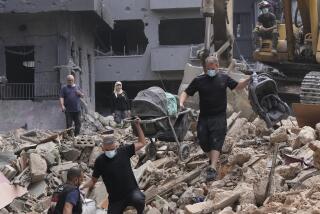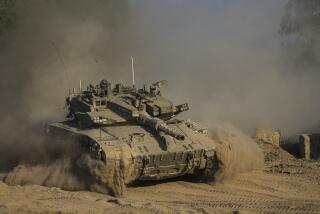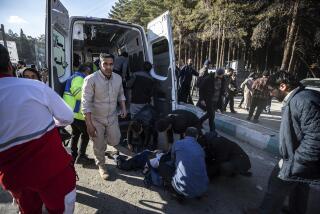Car bombs kill at least 172 in Baghdad area
- Share via
BAGHDAD — Five car bombs exploded in and around Iraq’s capital on Wednesday, killing at least 172 people and injuring more than 220 in the deadliest day for the city since U.S. and Iraqi forces launched a much-publicized security crackdown two months ago.
Four of the bombs targeted predominantly Shiite Muslim neighborhoods, sparking heated criticism of the security plan and heightening fears of revenge attacks and death squad killings.
The deadliest attack killed 140 people in Baghdad’s Sadriya district, which was still recovering from a February car bombing that killed at least 130 people in a busy marketplace.
The attacks could be a setback for U.S. and Iraqi security forces, which on Feb. 13 announced an aggressive plan to deploy thousands of additional personnel in and around Baghdad.
Hundreds of new traffic checkpoints sprouted up overnight. U.S. troops increased raids on suspected insurgent strongholds, arresting 3,000 people in two months. U.S. and Iraqi officials began establishing outposts in 10 districts of the city to bolster confidence.
But insurgents have demonstrated an equal determination to undermine the crackdown. Last week, they blew up a key bridge spanning the Tigris River in Baghdad, and a suicide bomber infiltrated the tight security of the Green Zone to detonate explosives in the cafeteria of parliament, killing a Sunni Arab lawmaker.
Victims of Wednesday’s late-afternoon attack in the Sadriya area included construction workers repairing buildings damaged in the Feb. 3 bombing and rush-hour commuters queuing up at a bus depot.
Survivors questioned the effectiveness of the government campaign.
“What security plan?” asked Qassim Nadhum, 40, who sells frozen meat in Sadriya and suffered shrapnel wounds to the head and shoulder. “The violence is continuing. All we get is traffic jams.”
Sattar Ali, 35, a bus driver who was injured, said the crackdown appeared to work at first but that insurgents now seemed to be pushing back harder. “This is not a plan, it’s just a show,” he said. “It’s a failure.”
Baghdad police also reported finding the bodies of 17 people, apparently victims of sectarian violence. That figure combined with the toll from the car bombings made Wednesday one of the deadliest days in the Baghdad area since the U.S.-led invasion in March 2003.
The U.S. military on Wednesday reported the death of an Army National Guardsman who died of noncombat injuries Saturday at Camp As Sayliyah in Doha, Qatar. His death is under investigation, officials said.
Iraqi Prime Minister Nouri Maliki ordered the arrest and investigation of the army commander responsible for security in the Sadriya district, saying the recent car bombings there have exposed weaknesses in the system to protect residents.
U.S. and Iraqi officials urged patience, insisting that the security plan was working, while critics said the attacks demonstrated the futility of the Bush administration’s policies in Iraq.
“We shouldn’t expect immediate results,” Shiite lawmaker Sahar Ata said. “We need to have time, at least a year.”
U.S. Defense Secretary Robert M. Gates said he had warned that insurgents would attempt to ramp up the violence to derail the crackdown. He pledged to show that the plan was not a failure.
“Today was a horrifying thing,” Gates told reporters in Tel Aviv. “But I think it illustrates another point: These terrorists are killing innocent men, women and children who are Iraqis.”
He said the bombings appeared to be an attempt to provoke Shiite militias to retaliate.
“We can only hope that the Shia will have the confidence in their government and in the coalition that we will go after the people that perpetrated this horror,” Gates said.
Congressional Democrats, who are locked in a debate with the Bush administration over a timeline for withdrawal of U.S. troops, seized on the bombings to push for a policy change in Iraq.
“They’re cleaning up the mess of a marketplace that was bombed out in February. They bombed it out again today and killed about 180 people,” Senate Majority Leader Harry Reid (D-Nev.) said after a meeting with President Bush to discuss war funding. “We need a new conversation about Iraq.”
Administration officials expressed condolences to the families of the dead, but they noted that only three of the five brigades that had been ordered to Baghdad as part of the new plan had arrived.
White House spokeswoman Dana Perino said such spectacular attacks, and higher death tolls among American troops, are to be expected as U.S. forces move into strife-torn neighborhoods and insurgents redouble their efforts.
“Anybody who thinks that this enemy is tired, they are mistaken,” Perino said. “They are a very determined enemy. They are watching what we are doing and what we are saying, and it’s critically important that we finish the job in Iraq.”
Witnesses to the Sadriya bombing said they saw a parked minibus explode, leaving a 15-foot-wide crater in the road and setting ablaze dozens of buses and taxis. Street vendors emptied their wooden carts of fruits and vegetables and used them to evacuate victims.
“It was really chaos,” said Abu Hussam, 51, who owns a paint shop nearby. “People are coming here to look for their loved ones.”
Heavy traffic hindered rescue efforts and heightened the death toll, police said. Bodies lined the hallways of hospitals.
Earlier in the afternoon, a suicide car bomber detonated his vehicle at the eastern gateway to Baghdad’s Sadr City neighborhood, near an Iraqi army checkpoint, the presumed target. At least 16 people were killed and perhaps as many as 30, according to conflicting reports from police and Interior Ministry officials.
“I saw vehicles burning and scattered bodies here and there,” said Abu Zahraa, 35, a security worker at Imam Ali Hospital who rushed to the bombing site. “It’s an unbelievable scene. Indescribable.”
Sadr City, the home turf of radical Shiite cleric Muqtada Sadr, has been a focal point of the security crackdown. The volatile district is largely controlled by Sadr’s Al Mahdi militia and has been a frequent target of attacks by Sunni-led insurgents.
Sadr and his militiamen have kept a low profile since the security plan was launched, but the cleric pulled his loyalists from the Iraqi Cabinet this week. His whereabouts remains unknown.
Before the crackdown, Al Mahdi militiamen often responded to such attacks with assassinations and armed raids on Sunni neighborhoods.
Other car bombs struck Baghdad’s Karada district, killing 10 and wounding 13; and Mahmoudiya, south of Baghdad, where four Iraqi soldiers were killed.
In Baghdad’s Saidiya district, a mixed Sunni-Shiite neighborhood, a suicide bomber attacked an Iraqi commando checkpoint, killing two people and injuring five.
*
Times staff writers Peter Spiegel in Washington, Julian E. Barnes in Cairo and Saif Hameed in Baghdad contributed to this report.
*
Begin text of infobox
Baghdad bombings
Four explosions killed nearly 170 people in Baghdad on Wednesday. A fifth bomb killed four Iraqi soldiers south of the city.
The day’s toll
1. Sadriya market, 4:05 p.m.: Parked car bomb kills 140
2. Sadr City, 3:05 p.m.: Suicide car bomber kills at least 16
3. Karada neighborhood, noon: Parked car bomb kills 10
4. Saidiya, 7 p.m.: Suicide bomber kills two
Note: Times approximate
*
Worst days
Some of the deadliest attacks in Iraq:
Nov. 23, 2006: Mortar rounds and car bombs kill 215 in Sadr City
March 27, 2007: Truck bombs, other incidents kill 198
March 6, 2007: 194 killed, including 120 by suicide bombers in Hillah
March 29, 2007: 179 killed in Khalis and Baghdad
April 18, 2007: Four bombs kill 168 in mainly Shiite areas of Baghdad
Feb. 3, 2007: 167 die, including 137 in suicide truck bomb explosion
Nov. 12, 2006: 159 killed, including 35 in a single bombing
More to Read
Sign up for Essential California
The most important California stories and recommendations in your inbox every morning.
You may occasionally receive promotional content from the Los Angeles Times.










